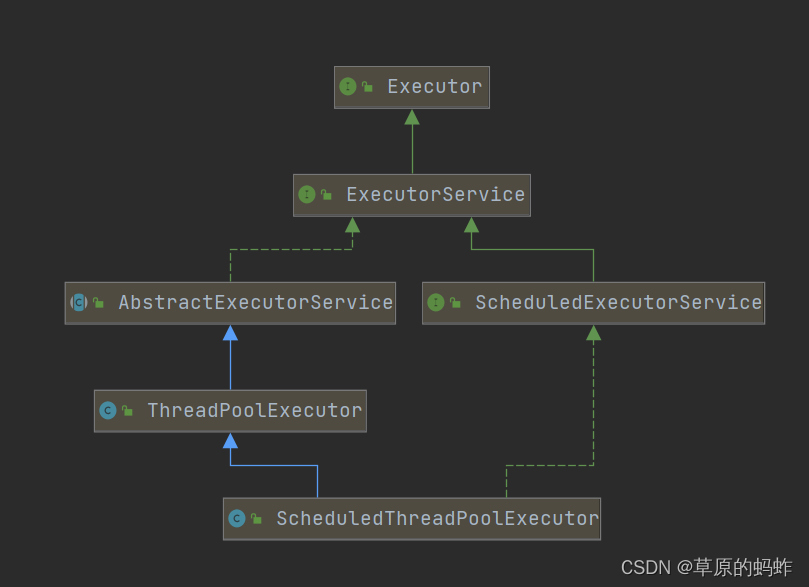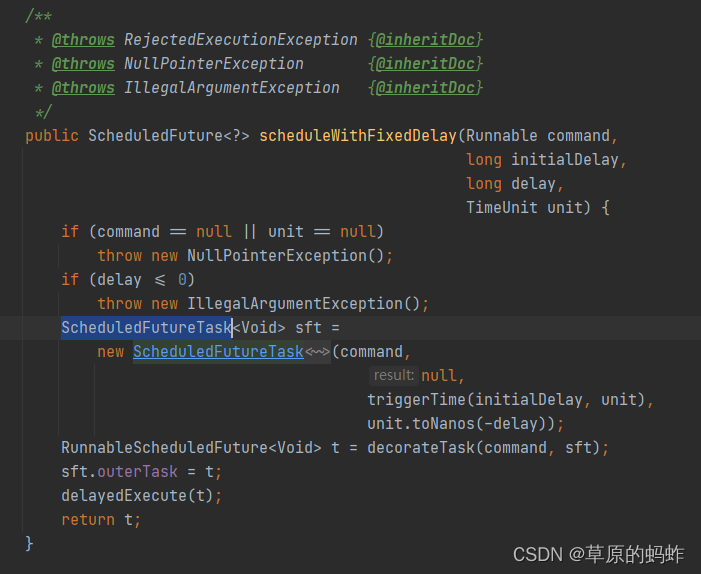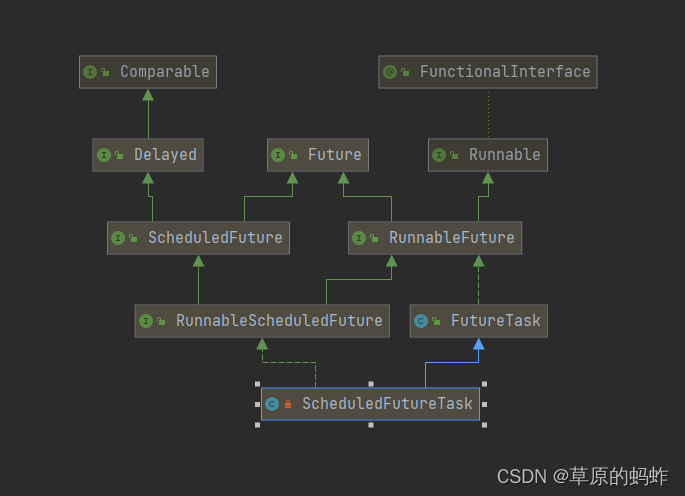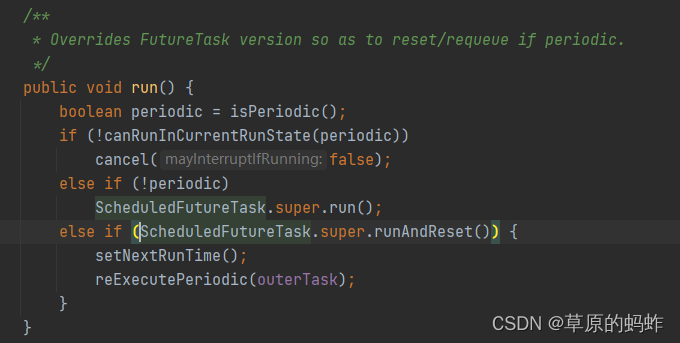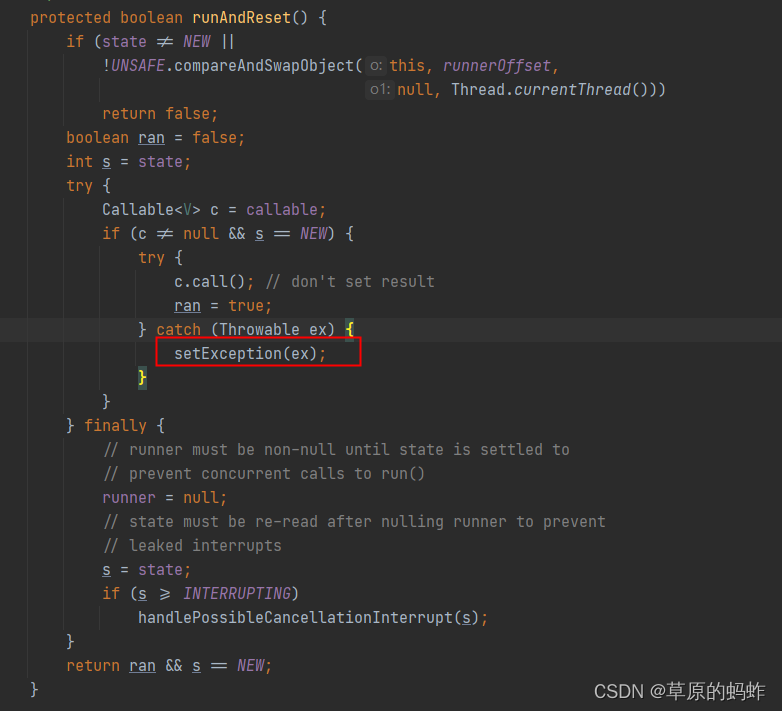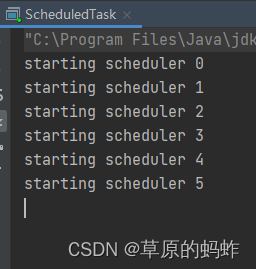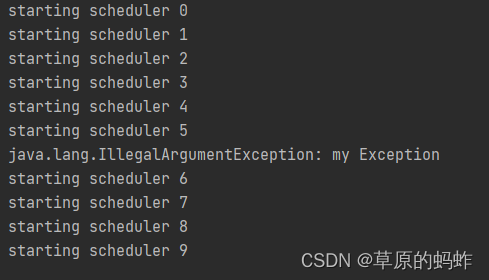ScheduledThreadPoolExecutor定时线程池不执行原因分析 |
您所在的位置:网站首页 › 定时任务不执行了 › ScheduledThreadPoolExecutor定时线程池不执行原因分析 |
ScheduledThreadPoolExecutor定时线程池不执行原因分析
|
项目场景:
公司同事封装了一个观察者模式,异步定时线程发送消息和更新Redis 问题描述公司同事封装了一个观察者模式,异步定时线程发送消息和更新Redis,但是Redis做了一次扩容,中间会有无法写入的异常,后来异步定时线程就不执行了 public DataChangedHandle(DataObservable dataObservable, SyncDataHandleConfigurer observer) { dataObservable.addObserver(observer); Executors.newScheduledThreadPool(2).scheduleWithFixedDelay(() -> { Iterator var1 = dataList.iterator(); while(var1.hasNext()) { DataEntity object = (DataEntity)var1.next(); dataObservable.setData(object); dataObservable.notifyObservers(); dataList.remove(object); } }, 5L, 1L, TimeUnit.SECONDS); } 原因分析:
通过类图可以看出 ScheduledThreadPoolExecutor 继承 ThreadPoolExecutor线程池且实现了ScheduledExecutorService接口, ScheduledThreadPoolExecutor 中的 scheduleWithFixedDelay方法延迟指定时间执行一次,之后按照:上一次任务执行时长 + 周期的时长 的时间去周期执行
ScheduledFutureTask继承FutureTask且实现RunnableScheduledFuture方法,ScheduledFutureTask重写了run方法,问题就出在这里, ScheduledFutureTask.super.runAndReset()如果为true, setNextRunTime():设置下次为定期任务运行的时间 reExecutePeriodic(outerTask):定期重新执行 其中执行的super.runAndRest方法内部,如果执行抛出异常,那么返回False,无法设置下次定时任务的时间和定期执行的方法,所以定时任务不执行了
原因小结: 当异常抛到ScheduledThreadPoolExecutor框架中时不进行下次调度时间的设置,从而导致ScheduledThreadPoolExecutor定时任务不调度。 解决方案:使用ScheduledThreadPoolExecutor的地方增加try-catch,异常捕获,不让异常抛到框架中即可解决 示例: package com.hgq.thread.scheduled; import java.util.concurrent.CountDownLatch; import java.util.concurrent.ScheduledThreadPoolExecutor; import java.util.concurrent.ThreadFactory; import java.util.concurrent.TimeUnit; import java.util.concurrent.atomic.AtomicInteger; /** * @description: ScheduledThreadPoolExecutor 执行周期性任务时,报错导致定时任务线程不执行 * @author: hgq * @time: 2023/5/4 10:08 */ public class ScheduledTask { public static final AtomicInteger count = new AtomicInteger(0); public static final ScheduledThreadPoolExecutor scheduler = new ScheduledThreadPoolExecutor(1, new ThreadFactory() { @Override public Thread newThread(Runnable r) { Thread thread = new Thread(Thread.currentThread().getThreadGroup(), r, "sc-task"); thread.setDaemon(true); return thread; } }); public static void main(String[] args) throws InterruptedException { CountDownLatch latch = new CountDownLatch(1); scheduler.scheduleWithFixedDelay(()->{ System.out.println("starting scheduler "+count.get()); if (count.get() == 5){ throw new IllegalArgumentException("my Exception"); } count.incrementAndGet(); },0,1, TimeUnit.SECONDS); latch.await(); } }执行结果:
通过结果可以看出,定时任务执行到第6次抛出异常后,定时任务就不执行了 解决方案: public static void main(String[] args) throws InterruptedException { CountDownLatch latch = new CountDownLatch(1); scheduler.scheduleWithFixedDelay(()->{ System.out.println("starting scheduler "+count.get()); if (count.get() == 5){ try { //抛出异常不去捕获的话,ScheduledThreadPoolExecutor定时任务的线程会停止执行, throw new IllegalArgumentException("my Exception"); }catch (Exception e){ System.out.println(e); } } count.incrementAndGet(); },0,1, TimeUnit.SECONDS); latch.await(); }增加代码异常捕获后,定时任务可以正常执行。 执行结果:
|
【本文地址】
今日新闻 |
推荐新闻 |
